The Top 3 Reasons Consumers Read Blogs in 2020 [New Research]
In 2020, there's no question of whether or not blogs generate leads.
In fact, marketers who prioritize blogging as a marketing strategy report 13-times the ROI of companies that don't.
However, many marketers still worry that blogging's effectiveness could be losing steam.
Fears that "blogging is dead" haven't been eased by research. Recently, when we polled over 300 people to ask them how often they read blogs, roughly 40% said "never." This followed HubSpot's 2020 State of Marketing Report, which revealed that blogging fell from the first to third-most-common content strategy between 2018 and 2020.
But, before you get wrapped up in all the negative data, it's important to remember that blogging is still incredibly valuable to marketers -- but the way you approach blogging matters more than ever. And, while our past survey found that 40% of people never read blogs, it conversely revealed that 60% of consumers read this content regularly.
The truth is, blogging is alive and well. You'll just need to work a tiny bit harder to persuade people to read your content in 2020.
So, what's one way to get into a consumer's head and figure out how to motivate them to read your blog? Performing another survey.
Rather than asking more than 300 people, "Do you read blogs?", I launched a second Lucid survey that more deeply asked, "Why do you most commonly read blog posts?"
In the survey, which asked participants to select the most common reason that they consume blog content, answer options included, "To learn how to do something new," "To be entertained," "To learn more about products or brands," and "To learn about news and trends in my job industry."
With the number of leads that business blogs are known to generate, you might assume that a large chunk of people read blogs to learn about brands or products. But, actually, you might be surprised -- and a little concerned -- by the highest and lowest-ranking reasons for blog readership:
In fact, only four percent of consumers say they read blogs to learn about brands or products.
According to the results of the survey, more people are actually driven to read blogs that teach them how to do something new. While 34% selected this reasoning, 20% said they read blogs to be entertained, while 12% read blogs to learn about news or trends in their job industry.
Additionally, 9% said they're driven to read blogs for all of the reasons given.
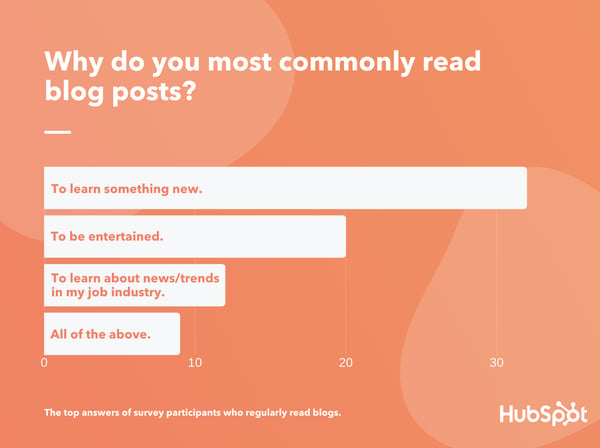
Data Source: Luc.id
What exactly do the results above mean?
To win over blog readers, you'll need to create content that provides some type of informative value or entertainment, rather than purely using your blog to discuss your brand or product.
In this blog post, I'll walk you through the top three reasons why the general consumer population is driven to read blogs. I'll also show you how to create blog content that fulfills your reader's needs while still subtly spreading brand awareness.
3 Reasons People Read Blogs
1. People read blogs to learn something new.
By far, the most common reason that people will read a blog post is to learn something new. This result doesn't surprise me at all.
Why? Posts that include guides, step-by-step processes, tutorial videos, or fast-facts often gain a large amount of search traffic. This is because people are looking up instructions for how to do things on Google every day.
Even when posts aren't informing people of how to do something on a granular level, blogs that discuss complex topics such as studies, trends, or topics people are less familiar with can pique a person's curiosity.
Psychologically, people crave new information similarly to how they crave food. As a blogger, you can harness this to create content that both piques curiosity, while discussing topics related to your brand, service, or products.
For example, on the Marketing Blog, we might show our readers how to publish an Instagram Story. By doing this, marketers or social media users who want to learn how to do this could find our content in search or on social media and read it to learn how to create this content.
On a broader scope, our blog might create multiple pieces of content that discuss a trend from multiple angles. For example, when the app TikTok emerged, we wrote a few blog posts to answer common marketer questions like, "What is TikTok?", "How do brands market themselves on TikTok?", or "How do you leverage influencer marketing on TikTok?"
Aside from helping our readers, guide or trend-related blogs allow us to highlight the level of research and knowledge we've gained as marketers. This could also demonstrate to a prospect that HubSpot is a credible company that sells quality products within the marketing industry.
2. People read blogs to be entertained.
While people crave knowledge, they also like to be entertained. Each day, people might read blogs that tell interesting stories, make them laugh, or intrigue them in some other way.
But, as a business blogger, You might be asking yourself, "How can I entertain my readers while still keeping my blog professional?"
The truth is, when you think creatively, there are a number of ways you can entertain your audience while still staying on brand.
For example, you could create a fun infographic or photo post about a viral trend in your industry, While your readers might not be willing to invest in this viral trend, the imagery and information about the trend might entertain them. In one of our posts, we highlighted funny memes that marketers used in their actual campaigns.
Alternatively, you could also create a fun, but informative, video or podcast to go with your blog post. With this added layer of content, you could dive deeper into discussing a viral marketing trend, or interview an industry expert that people in your field follow. While this might not be "entertaining" for people outside of your industry, it might be more interesting than the average blogs people in your field might be reading.
Here's an example of a blog post that combines text and video for a better reader experience:
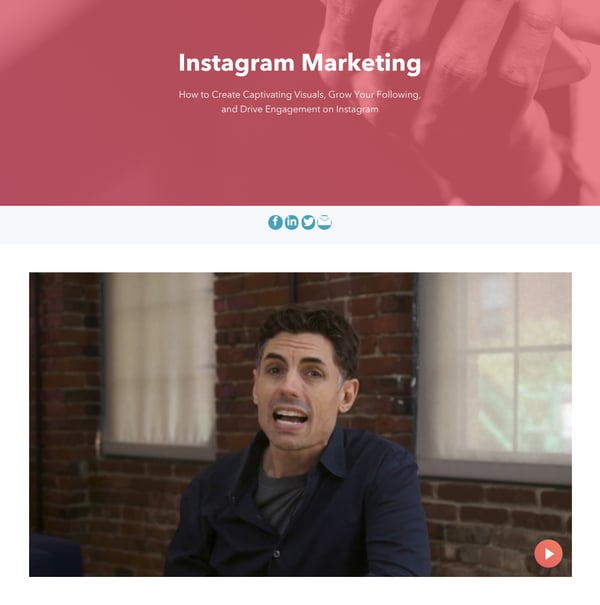
3. People read blogs to learn about trends related to their job industry.
While people might not be interested in reading blogs that specifically discuss your product or brand, they could be more intrigued by a blog that discusses an industry your product is affiliated with.
While the poll result noted in the introduction came from general consumers with mixed professional backgrounds, it's likely that those in the workforce will read a blog if it educates them or provides them with valuable information about their industry.
One example of a brand that discovered how industry experts read its industry-themed blog is American Scientist. Recently, the science blog conducted a study to learn about what motivated its blog readers to visit its site. They found that the average reader was either highly educated in science and technology or was actively working in STEM fields.
American Scientist also discovered that these readers, who already had some expertise on the topic, weren't interested in general science news. They were actually interested in reading the American Scientist blog for specific "nuggets" of new scientific information, studies, or findings.
From the above study, and what we've learned when developing HubSpot's Marketing, Sales, and Service blogs, industry experts or professionals will read blogs to learn something more specific about their industry. Here's an example of one of our own high-performing blog posts where an industry thought leader discusses the ins and outs of organic growth.
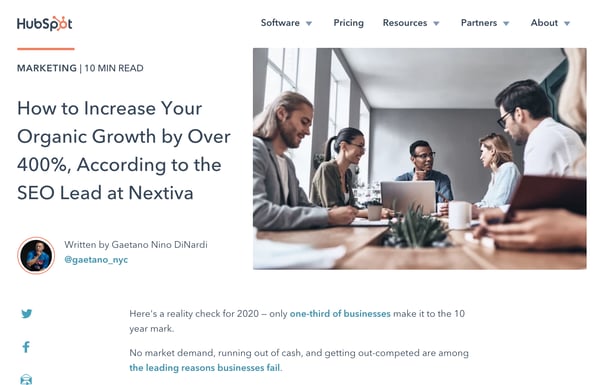
To zone in on your particular industry, experiment with tactics like thought leadership, similarly to the post noted above. You can additionally write about news or trends related to your field. For example, here's a post where we discussed how a third-party cookie phaseout could impact marketers.
Creating Content That Fulfills Multiple Reader Needs
So, how do you create engaging content that pulls in audiences with all different reading motivations while still spreading brand awareness about your product or service? Consider publishing blog posts that combine industry trends, how-tos, and entertainment. After all, nine percent of the survey recipients polled above said they read blogs for all of the reasons on the list I gave.
Here are two examples of how you can create content that fulfills the interests of multiple groups of blog readers.
Teach your readers how to do something in your industry.
At the HubSpot Blog, each of our posts teaches readers about something specific. For example, the post you're currently reading highlights the research we've done about how people read blogs and shows you how to leverage these results.
In other posts, we'll also inform marketers by giving them a step-by-step guide to a marketing tactic or examples of how brands leverage promotional trends. Regardless of what we write about, we're always trying to teach readers something valuable.
When you create content that educates people about strategies related to your industry, it's also easier to subtly discuss your product in a way that doesn't seem shameless of over promotional.
For example, when we're discussing a strategy that HubSpot can help with, we might subtly link readers to a tool or resource we offer that can help them. Here's an example of a HubSpot mention in a post about form building tools:
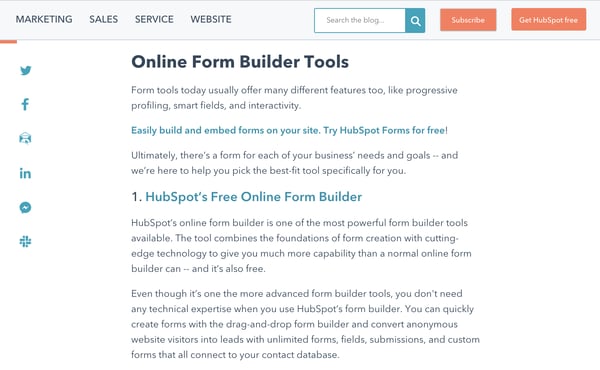
We also like to include free offers related to our content at the end of each blog post. When we do this, a reader can learn more about the topic we've just taught them about. And, when they fill out a simple form requesting the free resource, they can choose whether or not they'd like to be contacted about one of our products. This allows the reader to feel like they are receiving valuable information without being forced to learn about our products.
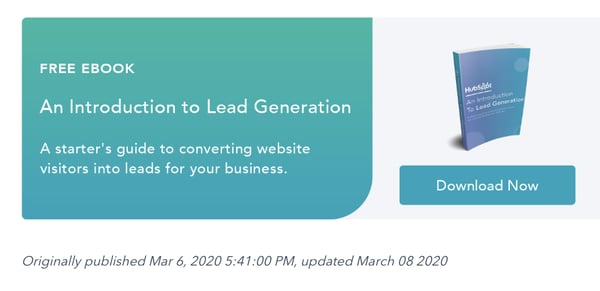
Even when you don't specifically acknowledge a product, an industry blog focused on informing readers can show off your company's level of expertise. When your brand is seen as highly knowledgeable about your industry, readers might think that your products were also created by your staff of industry experts.
Entertain industry readers while still informing them.
Even though an industry blog will likely target company employees or leaders, this doesn't mean your content can't be informative and entertaining. For example, you can use videos, GIFs, imagery, or interactive blog assets to add to your content while keeping it interesting for the reader.
For example, you could consider embedding a trivia or personality quiz related to your industry, as we did in this blog post:
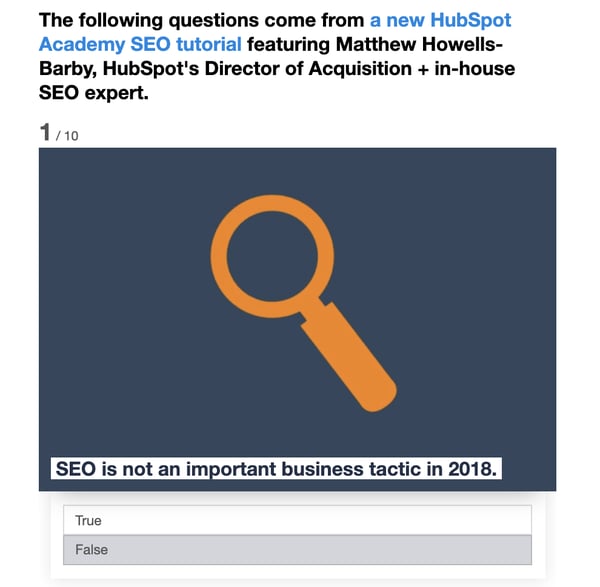
On occasion, you could also create a fun, suitable for work posts that your industry readers can relate to. For example, here's a Service Blog post where we highlight GIFs related to working on a customer service floor:
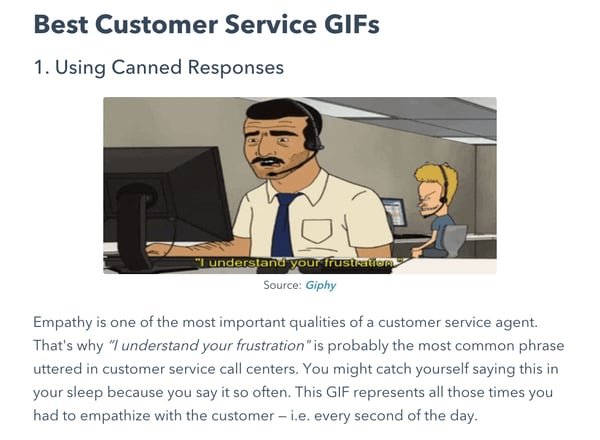
Entertaining blog content on an industry blog can similarly show off your expertise. But, importantly, this content also allows your reader to relate to your brand on a more human level.
Building an Effective Blog Strategy
While it can be great to run with one successful content type, the blogs with the most credibility and quickest growth often have a mix of content that entertains or informs readers, makes them aware of brands or products, or teaches them something new. And, with 9% of consumers in the poll above saying that they'll read blogs for "all" reasons listed, there's a good chance that a mix will intrigue and fulfill the reading needs of multiple different groups.
To learn more about how to drive internet users to your blog, check out this post. For tips on how to be a blogger, check out this post with advice from our own blog team.
from Hubspot
Comments
Post a Comment